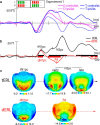Cortical Mechanisms of Prioritizing Selection for Rejection in Visual Search
- PMID: 29691330
- PMCID: PMC6596014
- DOI: 10.1523/JNEUROSCI.2407-17.2018
Cortical Mechanisms of Prioritizing Selection for Rejection in Visual Search
Abstract
In visual search, the more one knows about a target, the faster one can find it. Surprisingly, target identification is also faster with knowledge about distractor-features. The latter is paradoxical, as it implies that to avoid the selection of an item, the item must somehow be selected to some degree. This conundrum has been termed the "ignoring paradox", and, to date, little is known about how the brain resolves it. Here, in data from four experiments using neuromagnetic brain recordings in male and female humans, we provide evidence that this paradox is resolved by giving distracting information priority in cortical processing. This attentional priority to distractors manifests as an enhanced early neuromagnetic index, which occurs before target-related processing, and regardless of distractor predictability. It is most pronounced on trials for which a response rapidly occurred, and is followed by a suppression of the distracting information. These observations together suggest that in visual search items cannot be ignored without first being selected.SIGNIFICANCE STATEMENT How can we ignore distracting stimuli in our environment? To do this successfully, a logical hypothesis is that as few neural resources as possible should be devoted to distractor processing. Yet, to avoid devoting resources to a distractor, the brain must somehow mark what to avoid; this is a philosophical problem, which has been termed the "ignoring paradox" or "white bear phenomenon". Here, we use MEG recordings to determine how the human brain resolves this paradox. Our data show that distractors are not only processed, they are given temporal priority, with the brain building a robust representation of the to-be-ignored items. Thus, successful suppression of distractors can only be achieved if distractors are first strongly neurally represented.
Keywords: human; ignoring paradox; magnetoencephalography; visual attention; visual search.
Copyright © 2018 the authors 0270-6474/18/384738-11$15.00/0.
Figures






Similar articles
-
Statistical Learning of Distractor Suppression Downregulates Prestimulus Neural Excitability in Early Visual Cortex.J Neurosci. 2023 Mar 22;43(12):2190-2198. doi: 10.1523/JNEUROSCI.1703-22.2022. Epub 2023 Feb 17. J Neurosci. 2023. PMID: 36801825 Free PMC article.
-
Learned and cued distractor rejection for multiple features in visual search.Atten Percept Psychophys. 2019 Feb;81(2):359-376. doi: 10.3758/s13414-018-1622-8. Atten Percept Psychophys. 2019. PMID: 30421366
-
Learning What Is Irrelevant or Relevant: Expectations Facilitate Distractor Inhibition and Target Facilitation through Distinct Neural Mechanisms.J Neurosci. 2019 Aug 28;39(35):6953-6967. doi: 10.1523/JNEUROSCI.0593-19.2019. Epub 2019 Jul 3. J Neurosci. 2019. PMID: 31270162 Free PMC article.
-
The spatial profile of the focus of attention in visual search: insights from MEG recordings.Vision Res. 2010 Jun 25;50(14):1312-20. doi: 10.1016/j.visres.2010.01.015. Epub 2010 Feb 1. Vision Res. 2010. PMID: 20117126 Review.
-
What to expect where and when: how statistical learning drives visual selection.Trends Cogn Sci. 2022 Oct;26(10):860-872. doi: 10.1016/j.tics.2022.06.001. Epub 2022 Jul 13. Trends Cogn Sci. 2022. PMID: 35840476 Review.
Cited by
-
The Rejection Template of Working Memory Operates after Attention Capture.Behav Sci (Basel). 2022 Nov 8;12(11):436. doi: 10.3390/bs12110436. Behav Sci (Basel). 2022. PMID: 36354413 Free PMC article.
-
Inhibition in selective attention.Ann N Y Acad Sci. 2020 Mar;1464(1):204-221. doi: 10.1111/nyas.14304. Epub 2020 Jan 17. Ann N Y Acad Sci. 2020. PMID: 31951294 Free PMC article. Review.
-
Attention expedites target selection by prioritizing the neural processing of distractor features.Commun Biol. 2021 Jun 29;4(1):814. doi: 10.1038/s42003-021-02305-9. Commun Biol. 2021. PMID: 34188169 Free PMC article.
-
The consequences of color chromaticity on electrophysiological measures of attentional deployment in visual search.iScience. 2025 Mar 20;28(4):112252. doi: 10.1016/j.isci.2025.112252. eCollection 2025 Apr 18. iScience. 2025. PMID: 40241762 Free PMC article.
-
Electrophysiological evidence for the optimal tuning of attention.Sci Rep. 2025 Feb 26;15(1):6908. doi: 10.1038/s41598-025-90687-9. Sci Rep. 2025. PMID: 40011619 Free PMC article.
References
-
- Braithwaite JJ, Humphreys GW, Hulleman J (2005) Color-based grouping and inhibition in visual search: evidence from a probe detection analysis of preview search. Percept Psychophys 67:81–101. - PubMed
Publication types
MeSH terms
LinkOut - more resources
Full Text Sources
Other Literature Sources
